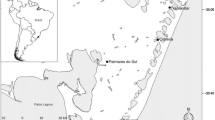Abstract
Southern Ural is a unique region in Eurasia with a high variety of flora and vegetation. Mountain relief predominates in the steppe and forest-steppe landscapes. Stony habitats and petrophytic vegetation are widespread here. It is characterized by a high diversity of flora and numerous endemic, rare, and endangered plants. The dataset of 3614 relevés of forb and shrub communities from the territory of Southern Ural and adjacent regions is analyzed. Formalized methods of cluster analysis, an assessment of moistening using the ecological indices of plants, and the definition of indicator species are used. Patterns of changes in the species composition of petrophytic communities along the moistening gradient are determined. It is found that, with an increase in moisture, the number and cover of petrophytic species in communities on rocky habitats decreases. On the contrary, the role of indifferent species is growing. Five groups of species indicating different gradient segments are determined. Based on the results of cluster analysis, four large units of petrophytic vegetation are identified. Desert-steppe communities have the greatest floristic originality among vegetation on rocky habitats. Obligate petrophytes predominate in their diagnostic combination, many of which grow on limestone outcrops. These communities are found in the south of Orenburg oblast, mainly in the dry steppe landscapes of Southern Ural. Dwarf subshrub–bunchgrass steppes are widespread within the steppe landscapes and are common in the forest steppe of Ural. Forb–bunchgrass petrophytic steppes are widely represented in the northern part of the steppe zone and in the southern forest-steppe regions, as well as in the forest-steppe landscapes of Middle Ural. Meadow petrophytic steppes are found in forest-steppe and forest landscapes.



Similar content being viewed by others
REFERENCES
Atlas Respubliki Bashkortostan (Atlas of the Bashkortostan Republic), Ufa: Roskartografiya, 2005.
Chibilev, A.A., Prirodnoe nasledie Orenburgskoi oblasti (Natural Heritage of Orenburg Oblast), Orenburg: Orenb. Knizhn. Izd., 1996.
Chibilev, A.A., Ural: prirodnoe raznoobrazie i evro-aziatskaya granitsa (Natural Diversity and Euroasian Border), Yekaterinburg: Ural. Otd., Ross. Akad. Nauk, 2011.
Chibilev, A.A., Stepnaya Evraziya: regional’nyi obzor prirodnogo raznoobraziya (Steppe Eurasia: Regional Review of Natural Diversity), Orenburg: Inst. Stepi, Ross. Akad. Nauk, 2016.
Diekmann, M. and Lawesson, J.S., Shifts in ecological behavior of herbaceous forests along a transect from Northern Central to North Europe, Folia Geobot., 1999, vol. 34, pp. 127–141.
Ellenberg, H., Weber, H.E., Düll, R., et al., Zeigerwerte von Pflanzen in Mitteleuropa, Scr. Geobot., 1991, vol. 18, pp. 1–248.
Fick, S.E. and Hijmans, R.J., Worldclim 2: new 1-km spatial resolution climate surfaces for global land areas, Int. J. Climatol., 2017, vol. 37, pp. 4302–4315.
Gorchakovskii, P.L., Historical phytogeography of Urals, Tr. Inst. Ekol. Rast. Zhivotn., Ural. Fil., Akad. Nauk SSSR, 1969, no. 59.
Hammer, Ø., Harper, D.A.T., and Ryan, P.D., PAST: Paleontological statistics software package for education and data analysis, Palaeontol. Electron., 2001, vol. 4, pp. 1–9.
Hill, M.O., Mountford, J.O., Roy, D.B., and Bunce, R.G.H., Ellenberg’s Indicator Values for British Plants. ECOFACT, Vol. 2: Technical Annex, Huntingdon: Inst. Terrestr. Ecol., 1999.
Kadil’nikov, I.P., Physical-geographic zonation of Bashkir ASSR, Uch. Zap. Bashkir. Gos. Univ., Ser. Geogr., 1964, vol. 16.
Kliment’ev, A.I., Soil-geographic zonation of Orenburg oblast, in Voprosy stepovedeniya (Problems of Steppe Science), Orenburg: Inst. Stepi, Ural. Otd., Ross. Akad. Nauk, 2005, vol. 5.
Knyazev, M.S., Family Fabaceae Lindl. in Urals: speciation, geographical distribution, historical, and ecological formations, Doctoral (Biol.) Dissertation, Yekaterinburg, 2014.
Korolyuk, A.Yu., Ecological maximums of the plants of Southern Siberia, Bot. Issled. Sib. Kazakh., 2006, no. 12, pp. 3–38.
Korolyuk, A.Yu., Communities of Festuco–Brometea class in West Siberian Plain, Rastit. Ross., 2014, no. 25, pp. 45–70.
Korolyuk, A.Yu. and Yamalov, S.M., Differentiation of ecological groups of species according to their reaction to moisture in differentiation of steppes of the West Siberian plain and Southern Urals, Contemp. Probl. Ecol., 2015, vol. 8, no. 20, pp. 162–172.
Kulikov, V.P., Konspekt flory Chelyabinskoi oblasti (sosudistye rasteniya) (Conspectus of Flora of Chelyabinsk Oblast: Vascular Plants), Yekaterinburg: Geotur, 2005.
Kulikov, P.V., Zolotareva, N.V., and Podgaevskaya, E.N., Endemichnye rasteniya Urala vo flore Sverdlovskoi oblasti (Endemic Plants of Urals in Flora of Sverdlovsk Oblast), Yekaterinburg: Goshchitskii, 2013.
Landolt, E., Ökologische Zeigerwerte zur Schweizer Flora, Veröff.Geobot. Inst. Eidgen. Techn. Hochschule (Zürich), 1977, vol. 64, pp. 1–208.
Lavrenko, E.M., Karamysheva, Z.V., and Nikulina, R.I., Stepi Evrazii (Steppes of Eurasia), Leningrad: Nauka, 1991.
Lebedeva, M.V., Yamalov, S.M., and Korolyuk, A.Yu., Ecological cenotic groups of species in Bashkir Trans-Ural steppes in relation to key ecological factors, Contemp. Probl. Ecol., 2017, vol. 10, no. 5, pp. 455–463.
Ramenskii, L.G., Tsatsenkin, I.A., Chizhikov, O.N., and Antipin, N.A., Ekologicheskaya otsenka kormovykh ugodii po rastitel’nomu pokrovu (Ecological Evaluation of Fodder Resources by Vegetation), Moscow: Sel’khozgiz, 1956.
Shakirov, A.V., Fiziko-geograficheskoe raionirovanie Urala (Physical-Geographic Zonation of Urals), Yekaterinburg: Ural. Otd., Ross. Akad. Nauk, 2011.
Teptina, A.Yu., Lebedeva, M.V., and Yamalov, S.M., Some communities of petrophytic steppes of Central Urals, Rastit. Ross., 2018, no. 33, pp. 92–106.
Tichý, L., JUICE, software for vegetation classification, J. Veg. Sci., 2002, vol. 13, pp. 451–453.
Yamalov, S.M., Bayanov, A.V., Martynenko, V.B., Muldashev, A.A., and Shirokikh, P.S., Endemic associations of petrophytic steppes of paleoreefs of Southern Urals, Rastit. Ross., 2011, no. 19, pp. 117–126.
Zverev, A.A., Infomatsionnye tekhnologii v issledovaniyakh rastitel’nogo pokrova (Information Technologies in Studies of Vegetation), Tomsk: TML-Press, 2007.
Author information
Authors and Affiliations
Corresponding authors
Ethics declarations
Conflict of interests. The authors declare that they have no conflicts of interest.
Statement on the welfare of humans or animals. This article does not contain any studies involving animals performed by any of the authors.
Rights and permissions
About this article
Cite this article
Korolyuk, A.Y., Yamalov, S.M., Lebedeva, M.V. et al. Patterns of Changes in the Composition of Petrophytic Vegetation in Southern Ural and Adjacent Territories on a Moistening Gradient. Contemp. Probl. Ecol. 13, 505–513 (2020). https://doi.org/10.1134/S1995425520050066
Received:
Revised:
Accepted:
Published:
Issue Date:
DOI: https://doi.org/10.1134/S1995425520050066




